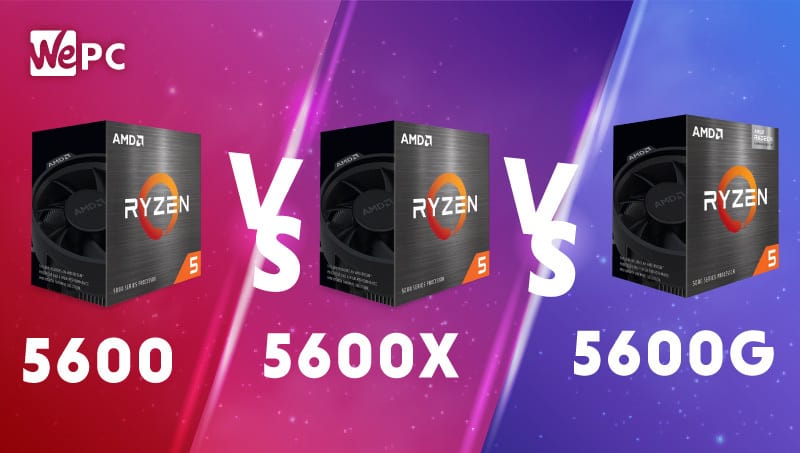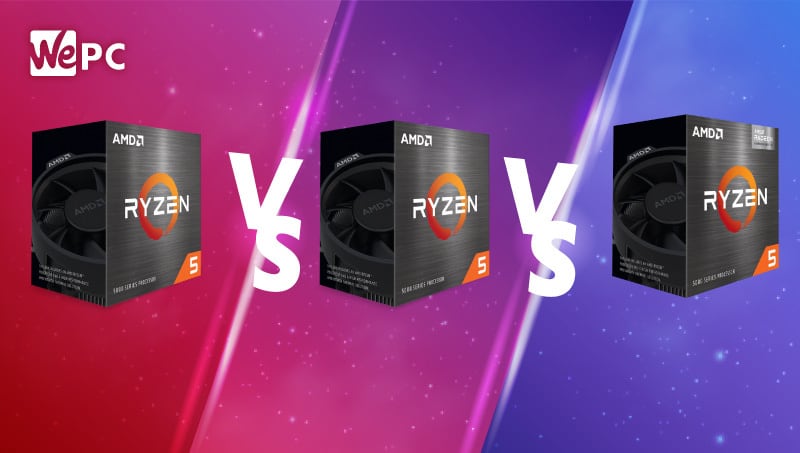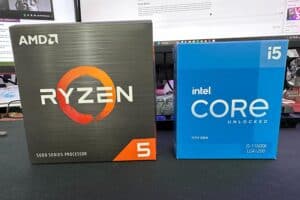AMD Ryzen 5 5600 vs 5600X vs 5600G
We compare three of AMD’s 5000 series to see how they stack up against each other in terms of price, specifications and performance.

WePC is reader-supported. When you buy through links on our site, we may earn an affiliate commission. Prices subject to change. Learn more
Today we’re looking at the 5600 vs 5600X vs 5600G CPUs and asking, which is better? AMD recently released the Ryzen 5 5600 and we’re looking to see how it stacks up against the already existing family of 5600 Ryzen processors, the 5600X and the 5600G. The Ryzen 5 5600 is an incredibly budget-friendly CPU with some impressive specifications for this price point. Let’s see how much fight AM4’s last release has.
If you’re interested in the latest Zen 4 or AM5 news, we have articles on them both
5600 vs 5600X vs 5600G: Specifications

When comparing any number of components it’s important to analyse the specifications of each to gauge how well they’re going to perform against each other on paper. Some examples of CPU specifications would be, clock speed, core count and cache size.
Ryzen 5 5600
The Ryzen 5 5600 is the newest release on today’s list debuting on April 4 2022. This is an extremely budget-friendly SKU and packs a punch in terms of specs at this price point. It’s said to be the predecessor to the Ryzen 5 3600 and it outperforms it beautifully.
The specifications of the Ryzen 5 5600 are as follows:
- 6 cores
- 12 threads
- Boost clock 4.4GHz
- Base clock 3.5GHz
- L1 cache 384KB
- L2 cache 3MB
- L3 cache 32MB
- Default TDP 65W
- Socket AM4
Ryzen 5 5600X
The Ryzen 5 5600X is a phenomenal CPU, initially released on May 11 2020. Superseding the Ryzen 5 3600X of the last generation and outperforming it by a margin of about 10%, can the 5600X maintain performance gains over the brand new 5600?
The specifications of the Ryzen 5 5600X are as follows:
- 6 cores
- 12 threads
- Boost clock 4.6GHz
- Base clock 3.7GHz
- L1 cache 384KB
- L2 cache 3MB
- L3 cache 32MB
- Default TDP 65W
- Socket AM4
Ryzen 5 5600G
The Ryzen 5 5600G is an APU meaning it has onboard graphics or an iGPU. The 5600G is one of the best APUs AMD has to offer, and was released on April 13 2021. This monster of an APU blew through its predecessors bringing never before seen APU performance to the table. But will it hold up against the all-new 5600?
The specifications of the Ryzen 5 5600G are as follows:
- 6 cores
- 12 threads
- Boost clock 4.4GHz
- Base clock 3.9GHz
- L1 cache 384KB
- L2 cache 3MB
- L3 cache 16MB
- Default TDP 65W
- Socket AM4
- Radeon Graphics
5600 vs 5600x vs 5600G: specification comparison
When comparing two or more components it’s important to get a grasp of their on-paper specifications. This helps us gain a greater understanding of how well each component will perform against each other. This also helps us analyse a use case for each, and fit it best to suit your personal needs. Some examples of CPU specifications are core count, core speed and cache size.
We will now compare the specifications of each CPU, and explain what that specification is and why it’s important.
Core count
All of the CPUs on today’s list have the same number of CPU cores.

A CPU with more cores will be more proficient at multitasking natively. This is because the extra cores your CPU possesses means it can process more instructions simultaneously at any one time. It all depends if the software you’re using supports a multi-core CPU, however, as some of the older software, games do not.
Most modern applications are designed specifically with multicore PCUs in mind. In most cases, it’s better to have a CPU with more cores at its disposal.
Thread count
All three of the CPUs on our list have the same thread count.

Threads are the name given to the second instruction a CPU core runs in addition to its main one. CPUs that are multithreaded have CPU cores that are able to process two instructions simultaneously. This increases the CPU’s efficiency and enables better performance.
This doesn’t double the CPU output as you might expect, however, as threads were not created equally. Threads are virtual and do not physically exist on the CPU die – they are merely an ability given to a CPU core. For this reason, they have to share the physical resources of CPU cores, which makes threads slightly slower as a result.
Generally, though, a CPU with more threads is the better option in terms of performance. If you want to learn more about simultaneous multithreading, you can do so in our ‘what is SMT’ article.
Core speed
The Ryzen 5 5600X has the highest core boost speed of 4.6GHz.

Core speed is the measurement of how many times per second a CPU can complete what’s called the ‘instruction cycle’. A CPU instruction cycle consists of three main actions: fetch, decode and execute. It’s these three cycles that comprise basic computing as we know it.
Generally, when speaking of CPUs in the same generation it’s safe to compare core speeds and determine the faster CPU as the one with the highest core speed and similar/more core and thread counts. Since all CPUs in today’s list have identical core and thread counts it’s safe to say that the 5600X takes the win here.
Cache
Both the 5600 and the 5600X have the highest cache capacity of 32MB.

A CPUs cache is an extension of the system’s RAM that is built close to CPU cores for ease of access and more importantly, speed. The CPU’s cache is incredibly important as cache speed and size have a direct impact on CPU performance.
Cache is split into three levels in today’s CPU architecture and they follow alphanumerical order.
- L1
- L2
- L3
Level one cache is the cache located closest to the CPU cores and has the fastest access speeds but also the lowest capacity. This is the level reserved for vital and frequented data.
Level two cache is a middle ground between level one cache and level three, with median capacity and speed, reserved for less vital data,
Level three cache is where most of your regularly accessed data is situated such as programs and file paths. This has a very large capacity in comparison to the other two levels but is also magnitudes slower.
TDP
All three CPUs on today’s list have a TDP of 65W.

TDP stands for thermal design power and is the maximum thermal energy output of the component under standard operating conditions. TDP can be indicative of how powerful a CPU is – more power is synonymous with a higher TDP.
Thermals are your enemy, however, and any heat generated by your CPU needs to be negated immediately. TDP is an important factor to consider when shopping for your next CPU as you need to make sure you already have adequate cooling to support it.
If you’re unsure how efficient your cooler is, check your cooler manual.
It’s important, considering all the CPU’s on our list support overclocking, that you have some thermal headroom, s the presence of higher voltages increases TDP exponentially.
Integrated graphics
The only CPU on our list with integrated graphics is the Ryzen 5 5600G.

It’s not the best APU AMD has to offer, that title belongs to the Ryzen 7 5700G, but with its Radeon graphics it can pack a heck of a lot more of a punch than a PC with no GPU. This iGPU can comfortably game at low to medium settings at 60FPS in less demanding titles.
However, it’s not all sunshine and rainbows. Incorporating a GPU die into the CPU package takes up precious CPU space and resources, meaning the CPU is forced to be smaller and slightly less powerful as a result.
This means that once you do install a GPU, the CPU portion may be left lagging behind and creating a bottleneck. This depends on what GPU you purchase, of course. This isn’t the kind of CPU you pair with a 3090, but it would do fine with something smaller, like a 3060.
If you’re on a budget and can’t afford a GPU right now, then this CPU is a great choice.
5600 vs 5600X vs 5600G: Benchmarks
Stay tuned for specific benchmarks as soon as they’re completed.
Price
The Ryzen 5 5600 is the most cost-effective CPU, coming in at a respectable $199 with a cost per core of $33.
The prices that can be found online at the time of writing are as follows:
- Ryzen 5 5600 – $199 – Cost per core $33
- Ryzen 5 5600X – $229 – Cost per core $38
- Ryzen 5 5600G – $209 – Cost per core $34
As you can see, the Ryen 5 5600 is definitely more cost-effective and is definitely one to consider if you’re looking for great performance in this category of CPU on a budget.
If you’re interested in picking up a Ryzen 5 5600, you can check out our Ryzen 5 5600 where to buy page.
5600 vs 5600X vs 5600G: Results

The Ryzen 5 5600 is our favourite here, the low price and the near performance of the 5600X when PBO is enabled is astounding, for around $30 less. The 5600X is the one to beat in terms of performance, but is the lead worth the extra cost? AM4 is at the end of its era and with the 5600 being the latest listing it should be in support for a little while longer than the other two CPUs.
If you’re on a tight budget then the 5600G has you covered with its relatively well-performing integrated graphics. Don’t be expecting to embark on 4k ultra-high graphic adventures with it though. We hope this 5600 vs 5600X vs 5600G article helped.










